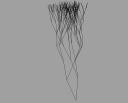Example Rhinoscript to import excel files into variables.
Category: Teaching
Align to Point Rhinoscript
A basic Rhinoscript to rotate surfaces to align their normal to a point.
Basic Branching RhinoScript
Etek EB-85A GPS Example Code
Here’s some example Arduino code for getting a Etek EB-85A module up and reading latitude and longitude (will probably work with most GPS modules). You can purchase a module from Sparkfun.
The module only needs power, ground, rx and tx. Most modules like the Etek start sending NMEA strings as soon as it has power. The Etek module takes a minute or two to get a satellite fix from a cold start in urban environments. Signals drop out once in a while between tall buildings at street level even with DGPS and SBAS. On a clear day, if you’re lucky, you can get a signal sitting by the window in urban canyons.
//Etek GPS EB-85A Module Example
//by Che-Wei Wang and Kristin O'Friel
//32 Channel etek GPS unit
//modified from original code by Igor González MartÃn. http://www.arduino.cc/playground/Tutorials/GPS
boolean startingUp=true;
boolean gpsConnected=false;
boolean satelliteLock=false;
long myLatitude,myLongitude;
//GPS
#include
#include
int rxPin = 0; // RX PIN
int txPin = 1; // TX TX
int byteGPS=-1;
char linea[300] = "";
char comandoGPR[7] = "$GPRMC";
int cont=0;
int bien=0;
int conta=0;
int indices[13];
//////////////////////////////////////////////////////////////////////////////////////////////////////////////////////////////////
//////////////////////////////////////////////////////////////////////////////////////////////////////////////////////////////////
void setup() {
//GPS
pinMode(rxPin, INPUT);
pinMode(txPin, OUTPUT);
for (int i=0;i CSV import for Processing
Here’s a some code for Processing to import csv files and parse the entries into a 2D array.
Surface Output Example
.dxf and 3D point position .txt file output and sunflow rendering example
ESS Jiggling Students Example
An example sketch using the Ess library to make a class of objects jiggle in response to the microphone input
Sensors Galore
An example of blobDetection, Ess, sms, and ocd all rolled into one sketch. Click and drag on the screen to move the HUD sliders around. (nothing is going to load here. copy the code to your processing sketch to run it)


